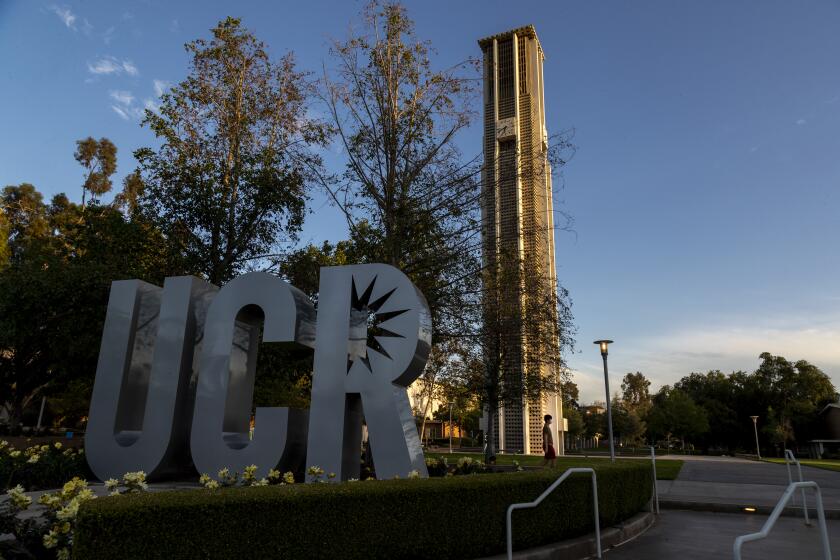Grocery negotiations deadline passes
With the door now open for a strike, and management and the labor unions at Ralphs, Vons and Albertsons preparing for another potential work stoppage, one thing is clear: The true winners would be competing grocery stores.
Since the last strike and lockout in 2003-04, which lasted 141 days, the three big grocers have hemorrhaged market share. As of 2004, the chains held nearly 60% of the Southern California grocery trade, according to the research firm Strategic Resource Group in New York. The share of Ralphs, Albertsons and Vons/Pavilions today: about 23%.
Farmers markets, discount shops, high-end specialty stores, small independents and big warehouse clubs have eaten into their business. New rivals such as Target Corp. are coming on strong. The discounter known for its hip fashions and home decor is attacking the grocery business with a vengeance. In Southern California, 140 of its stores now carry fresh groceries, a change that’s happened in just 15 months.
“That’s the fastest conversion rate in a retailer in that region that we’ve ever seen in U.S. history,” said Burt P. Flickinger III, managing director of Strategic Resource Group.
Management of Target and other non-union grocery companies declined to comment about a possible walkout. But analysts say it could be a boon for them, sending thousands of new customers through their doors, perhaps for good.
That’s because grocery shopping is a routine. Consumers tend to stick with what they know. Reluctant to cross picket lines during the 2003-04 strike, many shoppers fled to the competition — and stayed there.
“Consumers don’t break habits easily,” said David M. Smith, an associate professor of economics at Pepperdine University’s Graziadio School of Business and Management in Los Angeles. “But once they broke that habit, they found out they liked these new options.”
If that strike was the first serious blow to Ralphs, Albertsons and Vons, the struggling economy has been the second.
Property values have plummeted. Food prices have steadily climbed. Recession-weary customers have become budget conscious, opting for less-expensive staples. That, in turn, prompted grocers to offer deep discounts and more varied products to continue attracting shoppers.
The competition, though, had already gotten a foothold.
Whole Foods has brought in customers eager for organic and sustainably grown products. Trader Joe’s has developed a cult following for its eclectic branding and low prices. Costco has become a weekly stop for large families. Ethnic markets such as Seafood City are catering to the region’s growing Asian population, while El Super and Superior Grocers have been successful in drawing Latinos.
Even the high-end gourmand set has gotten away, at least for Albertsons’ parent company. Struggling against mounting pressure from big-box food retailers, grocery chain SuperValu Inc. sold off its Bristol Farms stores last year to a team of local store management and a West Coast investment firm.
Today, Ralphs, Vons and Albertsons have fewer stores in Southern California, and fewer employees. Albertsons has closed 67 locations since the 2003-04 strike and worker lockout. Ralphs has closed 48 stores, and Vons and Pavilions are down 47.
The competition is filling the gap. Unified Grocers, which represents at least 526 stores owned by independent chains, controls 12.1% of the grocery market in Southern California and Las Vegas, according to research by the Shelby Report, a grocery industry publication.
Trader Joe’s, with 106 stores, has 5.4% of the market. Smart & Final, Tesco’s Fresh & Easy and Whole Foods combined control another 5.4%, according to the report.
Although these companies all target different consumers, they have one thing in common: They are, for the most part, non-union shops. And like the airline and auto industries, the three big unionized retailers all have legacy health, pension and payroll costs that put them at an economic disadvantage.
Smaller chains can also tailor individual stores to the tastes of the neighborhood.
For independent grocer Jax Markets in Anaheim, that means packaging meat in smaller containers and wooing customers with personalized service. The four-store chain caters to predominantly Latino shoppers. A number of its customers don’t have cars, so the grocer offers a free shuttle service for anyone who lives within a five-mile radius of a store and is willing to spend a minimum of $30 in their trip to the grocery store.
“When the gas prices were going up, I wondered, ‘Is it really worth it?’ But it is,” said W. Bill MacAloney, chief executive of Jax Markets. “People are shopping around, and that gives us an opportunity. So we need to do what we can to help our customers.”
Serving ethnic shoppers can go beyond carrying brands they like. A number of economic factors persuaded Vons to close one of its locations in a working-class Latino neighborhood of Long Beach. Superior Grocers snapped up the outlet in 2003, before the strike, and transformed it into a mid-size store with bargain-priced produce and fast-moving register lines.
On a recent Monday afternoon, a mostly Latino crowd jammed the produce section, plucking up bags of mangoes the size of softballs for 99 cents each. Customers reached for fresh tortillas made in the store, freshly baked French rolls and loaves of Mexican sweet bread. Flat-panel TVs played Spanish-language news clips. On the overhead speakers, daily specials rang out in English and Spanish.
Four miles to the southeast, in the upscale Belmont Shore neighborhood, Vons operates one of its smaller specialty stores, known as the Market by Vons. Sparkling clean and quiet as a library, the store features a bounty of wine and a limited produce selection. Mangoes there cost $1 more than at Superior Grocers and were half the size.
“I love this Vons, but I don’t shop here all the time,” said Patty Barnett, 38, an artist who lives in downtown Long Beach. “I shop where there are sales.”
Whether she’ll see a picket line in the coming days in front of her favorite Vons outlet is unclear. On Sunday, the United Food and Commercial Workers and the grocers continued talks into the night despite the passing of a negotiations deadline. Union officials Thursday gave the employers 72 hours notice to cancel the labor contract’s extension, a mandatory step before a walkout.
Labor negotiations have dragged on for more than eight months.
Some industry and labor experts warn that another lengthy strike, with at least 54,000 Southern California union members out of work, could have serious ripple effects on the region’s fragile economy.
“That is more than the number of people being laid off from Bank of America,” said Smith of Pepperdine University.
Analyst Flickinger said competitors would be well-prepared to take advantage of a strike, just as they were in 2003-04. Only this time, he said, the retailers probably would have social-media campaigns ready to go in order to woo customers away from the big three chains with email blitzes and online advertising.
“If there really is a strike,” he said, “then every week will be like Thanksgiving, Hanukkah, Christmas and New Year’s for the competition, in terms of sales volume.”
More to Read
Start your day right
Sign up for Essential California for news, features and recommendations from the L.A. Times and beyond in your inbox six days a week.
You may occasionally receive promotional content from the Los Angeles Times.





